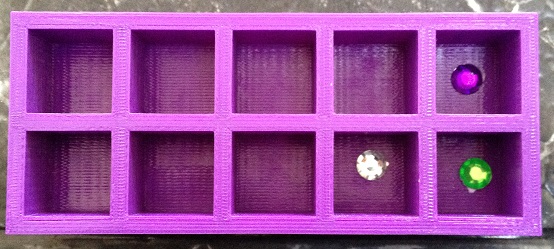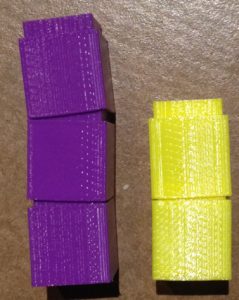I will start this chapter by sharing some examples that others have made for Thingiverse Education.
This activity gives a visual for how different angles compare to each other. In this activity students make a 3D protractor to get a good visual for whatever angles they put on it.
This activity gives a good manipulative for adding and subtracting fractions.
This activity gives students an understanding of measurement. Students get manipulatives that represent an inch, a half inch, a quarter inch, and an eighth inch.
This activity gives students a manipulative to help with solving word problems.
This activity gives students a manipulative to help with multiplying whole numbers and fractions.
Composing Eleven through Nineteen
This activity is designed for a Kindergarten classroom. Students will be using 3D printed Cuisenaire rods to decompose the numbers 11 through 19. This activity satisfies the following Common Core Standard:
CCSS.Math.Content.K.NBT.A.1
Compose and decompose numbers from 11 to 19 into ten ones and some further ones, e.g., by using objects or drawings, and record each composition or decomposition by a drawing or equation (such as 18 = 10 + 8); understand that these numbers are composed of ten ones and one, two, three, four, five, six, seven, eight, or nine ones.
First, you will need to print some Cuisenaire rods found here. Start by giving each student a rod of length ten. Ask students to count with you or to count on their own to show that there are ten little cubes on the rod. Repeat this as necessary until everyone is convinced it is length ten. Next, have students get into pairs and give each pair a different length rod ranging from one to nine. Ask them to count how many cubes are in the rod they just received. If students can write ask them to record the ten and the number they counted. Next, ask students to count all of the cubes on both rods and, if they can, record the total number they got.

Ask students to share their answers and how they got them. During this discussion you can ask students what ten plus five is (or whatever number they got for the second rod length).
Subtracting
This activity is for a first grade classroom. It satisfies the following Common Core Standard:
CCSS.Math.Content.1.OA.B.4
Understand subtraction as an unknown-addend problem. For example, subtract 10 – 8 by finding the number that makes 10 when added to 8.
You will need to print a ten frame for each student or group. One example can be found here. Start by giving students subtraction problems like the one shown in the standard. I will look at 10-3. If students have not used the ten frame before make sure that they know there are ten spots. Have them count and verify this. Then ask them to place objects in three of the spots. I used jewels but any kind of object will work. Now, ask them to count how many open spots there are. So if they have ten free and then take away three of those spots, there will be seven left.

Students can then do more examples of taking ten and subtracting a number. If you would like to start with a number other than ten you can start by putting objects in some of the spots. For example, if I want to find 8-4 I will start by counting eight spots and putting objects in the remaining two. Now follow the same process as before. I start with eight free spots and put objects in four of them and count how many are still empty.
Place Value
This activity is for a second grade classroom. It satisfies the following Common Core Standards:
CCSS.Math.Content.2.NBT.A.1
Understand that the three digits of a three-digit number represent amounts of hundreds, tens, and ones; e.g., 706 equals 7 hundreds, 0 tens, and 6 ones. Understand the following as special cases:
CCSS.Math.Content.2.NBT.A.1.a
100 can be thought of as a bundle of ten tens — called a “hundred.”
CCSS.Math.Content.2.NBT.A.1.b
The numbers 100, 200, 300, 400, 500, 600, 700, 800, 900 refer to one, two, three, four, five, six, seven, eight, or nine hundreds (and 0 tens and 0 ones).
For this activity you should print some base ten blocks as found here. If students haven’t used base ten blocks before make sure that they understand there are single cubes that represent ones, sticks with ten cubes put together to represent ten, ten of these sticks put together to represent one hundred, and ten hundreds to represent one thousand. A good way to start is to not say the relationships, but rather just give students the various blocks and ask them to make observations about how they relate to each other. This can lead to a class discussion.
Next, give students different numbers and ask them to come up with a way to represent that number with the blocks. For example, you may give eighty four. The simplest way to get this number is to use eight 10 blocks and four 1 blocks. After going through several examples have students share and explain their answers. If there are students who don’t use the simplest way (i.e. using the eighty four example a student may choose seven 10 blocks and fourteen 1 blocks) make sure to have them share. If there are not you can just show an example like this. Ask students to think about which method took more work. Through class discussion you can help students realize that it is much easier to take a 10 block rather than using ten 1 cubes. Give students another example, such as 115, and ask them to find the simplest way to represent it. At this point start asking students to count how many thousand, hundred, ten, and one blocks they used and to write the number in terms of them. For example, using 115 they will use 1 hundred, 1 ten, and 5 ones so they will write this as 100+10+5. Have students work through many of these examples.
Bar Graphs
This activity is for a second grade classroom. It satisfies the following Common Core Standard:
CCSS.Math.Content.2.MD.D.10
Draw a picture graph and a bar graph (with single-unit scale) to represent a data set with up to four categories. Solve simple put-together, take-apart, and compare problems using information presented in a bar graph.
For this activity you should print ten unifix cubes of various colors for each group. The cubes can be found here. Students will model word problems using the unifix cubes by setting up bar graphs. You can give various word problems such as the one shown here.
Molly has three purple hats and two yellow hats. How many hats does Molly have altogether?

Lego Fractions
This activity is for a third grade classroom when students are first introduced to fractions. It satisfies the following Common Core Standards:
CCSS.Math.Content.3.NF.A.1
Understand a fraction 1/b as the quantity formed by 1 part when a whole is partitioned into b equal parts; understand a fraction a/b as the quantity formed by a parts of size 1/b.
For this activity you should print some Legos. I used the ones found here. For each student or group you will need at least one 8 x 2, two 4 x 2, four 2 x 2, and eight 1 x 2 Legos. Start with the 8 x 2 Lego as the “whole.” Show students that two of the 4 x 2 Legos fit on the whole and explain that each piece is ½ of the whole piece. If the whole Lego is split into two equal parts you would get two 4 x 2 pieces. Then ask students to take out the 2 x 2 Legos and see how many they can fit on the whole Lego. In a class discussion have students share the number of Legos that fit, how many equal parts the whole is split into, and what fraction of the whole each 2 x 2 Lego represents. Repeat this process with the 1 x 2 Legos. If you want to give an extra challenge you can also print some of the 3 x 2 Legos found here and ask the same questions. Most likely a group will cover the whole with two 3 x 2s and one 2 x 2. You can use this to stress that the parts must be equal.
